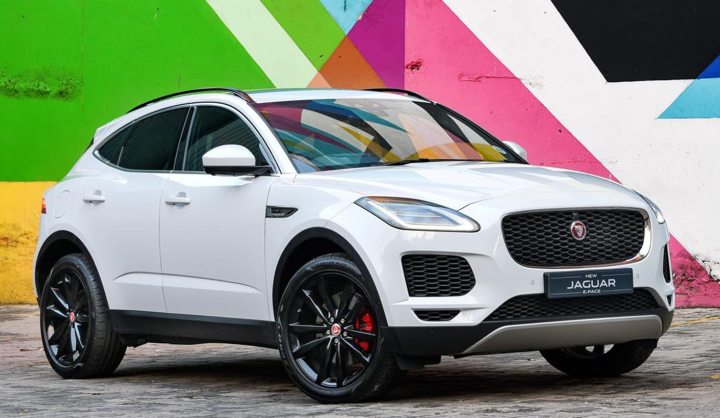Maverick Life, Motoring
Motoring: Jaguar E-Pace – more sport than utility

The Jaguar E-Pace is the British marque’s first compact SUV. Borrowing visual elements from the racy F-Type coupé and offering the ride and handling of something smaller and sportier, the newcomer is more about brio than practicality. Is that a good thing? Well, that depends on who’s driving … By DEON SCHOEMAN.
Just why would a brand like Jaguar want to build and sell sports utility vehicles (SUVs)? After all, we’re talking a famous British motoring brand with both heritage and tradition on its side – a producer and purveyor of fine (and often fast) cars.
Well, things change. Worldwide, the motoring appetite for anything remotely SUV appears insatiable. Even thoroughbred sports car makers like Porsche, Lamborghini and Maserati are making them. Ferrari will follow suit soon, as will that doyen of exclusive motoring, Rolls Royce.

The message is clear: give the market what it wants. And what it wants right now is a veritable barrage of SUVs – small or large, rugged or luxurious, stately or sporty, but definitely SUV.
As a result, station wagons are on the endangered list (they’re effectively extinct in South Africa already). Large sedans could well follow suit. And even the traditional hatchback is under threat from a new breed of compact and subcompact SUVs.
Jaguar’s foray into the SUV arena started with 2016’s F-Pace – a medium-sized beast intent on tackling BMW’s X5, the Mercedes-Benz GLE and the Audi Q5.

For those seeking something different in the premium SUV space, the F-Pace has been a godsend – but it doesn’t convince on all levels. It may be pretty, but the interior execution is patchy.
Besides, the F-Pace is priced at a premium, compared to its rivals. Still, it’s been finding upwards of 50 buyers a month in SA.

The new E-Pace is an altogether different proposition. It crosses swords with the recently updated Mercedes-Benz GLA, BMW’s X1 and new X2, Audi’s Q2 and ageing Q3, as well as the Range Rover Evoque and the soon to be launched Volvo XC40.
Tested in D240 HSE R-Dynamic guise here, the E-Pace is smaller, chunkier and more aggressive than its senior F-Pace sibling. It’s also a real looker – and all the more convincing for it.
The muscular, elevated stance is what you’d expect of an SUV, but those big 20-inch wheels and the short rear overhang are pure sports car. Indeed, some stylistic elements of the E-Pace doff an aesthetic hat to the F-Type sports coupé.

That’s especially true of the rear, where the slim taillights are a slash of colour that dissects the metalwork’s edgy contours. A pronounced roof spoiler, and the way the dual exhausts jut from the rear diffuser, continue the dynamic theme.
The front’s oversized grille is arguably over the top, but then, it’s also unmistakably Jaguar, which is the whole point. The equally hungry air intakes and the front splitter are further proof that the marque is keen on emphasising the E-Pace’s sports car heritage.
Admittedly, the car featured here benefits from the R-Dynamic package. But while humbler versions are a little more understated on the cosmetic front, they’re still undeniably extrovert. The E-Pace turns heads – and for all the right reasons.

Inside, the compact SUV lives up the Jaguar’s premium promise. Tactile quality is impressive, with stitched leather upholstery, soft-touch surfaces and sturdy switchgear all creating a reassuringly solid and inviting ambience.
Front accommodation is as comfortable as it looks, and there’s plenty of stowage space, including a deep centre console load box with cupholders and integrated armrest. USB and Bluetooth look after connectivity and you can even create an LTE-driven wi-fi hotspot.
The rear seating on a 60:40 split bench could be more generous: it’s adequate, but not exactly generous, especially in the legroom department. The boot is smaller and shallower than expected, even if Jaguar’s claim of 484 litres is right in the segment ballpark.

Okay, so you can fold down the rear seat backrest to increase capacity, but that effectively turns the E-Pace into a two-plus-luggage machine. If you’re a family of four, pack lightly when going on holiday, or opt for a tow hitch and a trailer.
This HSE model has everything that opens and shuts, but even the most basic specification ticks just about every important convenience and safety box. Unlike the HSE, you’ll have to make do without the leather, configurable digital instruments, auto wipers and lights, satnav and fancy Meridian sound.

But you do get two-zone air-con, LED headlights, cruise control, central locking, six airbags, an extensive portfolio of active safety systems, front and rear parking sensors with reverse camera, and a bright 25cm touchscreen for the infotainment system.
The screen works a treat, but it isn’t adequately recessed in the dashboard, so that sunlight can often make it difficult to read
So the compact Cat looks sporty, and it’s nicely kitted out. But how does it behave on the road? Engine-wise, E-Pace buyers are spoilt for choice, with an array of three turbodiesel and two turbo petrol mills, all with a 2.0-litre capacity.
Power output ranges between 110kW and 177kW in the case of the diesels, while the two petrol units deliver 183kW and 221kW respectively.

A nine-speed auto gearbox is standard across the range, as is full-time all-wheel drive. The latter is front wheel-biased, but sends urge to the rear wheels when and if required. It can even vary power between the left and right rear wheels.
The E-Pace may share the same platform as the Land Rover Discovery Sport, but the Jag’s suspension set-up is bespoke, with a clear emphasis on keen handling, tenacious grip and overall composure.
The downside is a ride that’s firm to the point of being unforgiving on anything but good motorway tar. Enthusiasts will enjoy being kept in touch with the chassis’ every move, but I’d wager that many would-be E-Pace owners would prefer a plusher ride.
At least the lower-specced models ride on 18-inch wheels (17-inch on baseline versions) with taller tyre profiles, which should soak up f those dips and bumps more effectively. The steering is precise and confidence-inspiring, but lacks progression, while the 11,4m turning circle is average.
Ride quality apart, the E-Pace is more refined than its sporty demeanour suggests. Wind and suspension noise levels are impressively low, and even the turbodiesel engine’s somewhat ragged growl is sufficiently muted most of the time.

With 177kW and 500Nm on tap, the D240 HSE R-Dynamic model I drove generally felt agile and responsive. But at just shy of two tons, this is no lightweight – it’s actually heavier than the larger F-Pace.
Combined with the Reef’s 1,600m altitude and the engine’s modest capacity, a measure of initial turbo lag is inevitable. With nine gearbox ratios to choose from, plus the option of manual mode with steering column-mounted shift paddles, that lag can be largely tamed. Switching to Dynamic driving mode (which ups throttle response and shift speed) also helps.
In the twisties, you could easily believe you were in something lighter and sportier, though. This is a vehicle that likes to be caned through the corners, and rewards the driver by toeing the chosen line, while limiting body roll and offering plenty of midrange grunt. Yes, it’s fun to drive when pressing on.
I doubt that anyone will want to head off the beaten track in an E-Pace, but it has the traction and the ground clearance (215mm on the rear axle) to tackle rougher stuff than your average sedan. Game farm gravel certainly won’t pose any problems.

It all boils down to target market and customer expectations. Petrolheads will revel in the E-Pace’s focussed dynamics. But in the SUV world, considerations such as interior packaging, practicality and comfort are also part of the equation, together with the all-important value proposition.
The 20-strong E-Pace model range suggests that there should be a variant to suit the needs and pockets of most premium compact SUV buyers, but its overt sportiness and limited utility remain potential negatives.
My guess is that the 132 kW D180 SE will become the range’s bestseller, offering a sweet-spot combination of spec, price and performance. At R719 900 before options, it’s not exactly cheap, but the package is a comprehensive one.
Yes the E-Pace has what it takes to become Jaguar’s best seller. But with BMW’s X2 launching next week, the Volvo XC40 around the corner, and an all-new Q3 overdue, it’s not going to get any easier … DM
PROS
Head-turning styling, engaging dynamics.
CONS
Relatively pricey. May well be too sporty for some.
VITAL STATS
| Jaguar E-Pace D240 HSE R-Dynamic | |
| Engine | In-line four-cylinder, 1,999cc, turbodiesel |
| Power | 177kW @ 4,000rpm |
| Torque | 500Nm @ 1,500rpm |
| Gearbox | Nine-speed automatic, AWD |
| 0-100 km/h | 7.4sec |
| Top speed | 224km/h |
| Fuel consumption | 6.2 litres/100km (combined cycle) |
| CO2 emissions | 162 g/km |
| Price as tested | R876 400 |















 Become an Insider
Become an Insider